You’ve got to hand it to [Les Wright]; he really knows how to dig into optical arcana and present topics in an interesting way. Case in point: an electro-optical control cell that’s powered by ouzo.
OK, the bit about the Greek aperitif may be stretching things a bit, but the Kerr Cell that [Les] builds in the video below does depend on anethole, the essential component of aniseed extract, which lends its aromatic flavor to everything from licorice to Galliano and ouzo. As [Les] explains, the Kerr effect uses a high-voltage field to rapidly switch light passing through a medium on and off. The most common medium in Kerr cells is nitrobenzene, a “distressingly powerful organic solvent” with such fun side effects as toxicity, flammability, and carcinogenicity.
Luckily, [Les] found a suitable substitute in the form of anethole — a purified sample, not just an ouzo nip. The solution went into a plain glass cuvette equipped with a pair of aluminum electrodes, which got connected to one of the high-voltage supplies we’ve seen him build before for his nitrogen laser. A pair of polarizing filters go on either end of the cuvette, and are adjusted to blank out the light passing through it. Applying 45 kilovolts across the cell instantly turns the light back on. Watch it in action in the video below.
There’s a lot of room left for experimentation on this one, including purification of the anethole for potentially better results. We’d also be curious if plain ouzo would show some degree of Kerr effect. For science, of course.
Continue reading “Electro-Optical Control Of Lasers With A Licorice Twist”














